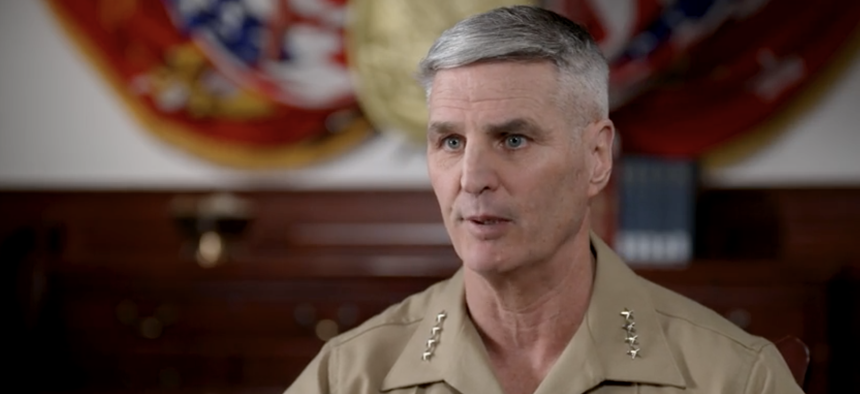
Defense One
Marines see progress with drones, despite flat budgets
However, a program to mount loitering munitions to vehicles faces delays.
The Marine Corps is seeing success with fielding futuristic loitering munitions and unmanned missile launchers, but the flat defense budget has constrained the pace of the service’s transformation, the service’s assistant commandant said Monday.
Most of the 96 programs linked to Force Design 2030, the Marine Corps’ sweeping modernization campaign, are “performing very well,” Gen. Christopher Mahoney said in an interview with Defense One.
Still, progress is slower than he’d like, Mahoney said, thanks in part to Congress’s failure to pass a new budget and resulting reliance on a series of continuing resolutions, which keep funding at the previous year’s levels.
“What we can't do is accelerate them as fast as I would like, and build a depth of magazine to the level that I would like,” he said.
Mahoney highlighted the Corps’ program to equip squads with one-way attack drones as one of the successes of Force Design so far. The program, dubbed Organic Precision Fire—Infantry (OPF-I), is “performing very, very well,” said Mahoney.
A capabilities integration officer for the Marine Corps earlier told Defense One that the Corps hopes to field loitering munitions at the squad level by 2027, and work is continuing to identify how best to handle the impact of weather on the storage and use of the sophisticated weapons.
The Marine Corps also runs a program for launching loitering munitions from vehicles in a program called Organic Precision Fire—Mounted, or OPF-M.
Mahony said OPF-M has “been a challenge, both from a technical standpoint, and from a performance standpoint,” but said the Marine Corps is continuing to work on the acquisition strategy.
The Corps in 2021 awarded a OPF-M contract to Israel’s UVision Air to integrate the Joint Light Tactical Vehicle with UVison’s Hero-120 loitering munition, which is designed to take out armored targets. Loitering munitions with an anti-tank capability in part fill the void in anti-armor weapons left when the Marine Corps got rid of tanks in 2020 as one of the first major Force Design changes.
This year’s budget also marks a period of investment in the Marine Corps’ new precision missile platforms, which match long range-missiles with an unmanned version of the Corps’ Joint Light Tactical Vehicle, dubbed the ROGUE Fires unmanned missile launcher.
For 2025, the Marines hope to acquire 90 Naval Strike Missiles for the Navy/Marine Corps Expeditionary Ship Interdiction System (NMESIS), which Mahoney called “one of my better performing programs.”
The service is also looking to buy eight Long Range Fires (LRF) systems, which launch the longer-range Tomahawk missile from a ROGUE Fires launcher.
The Marine Corps will focus on making the system as a whole “smaller and lighter,” Mahoney said. “It's the logistics train that would follow In the immediate physical footprint that we're trying to shrink down to be more expeditionary.”
The Corps will also look for heavy lifting drones to ferry supplies across the vast Pacific without risking the lives of logisticians. Last year, the service began operating a small logistics drone capable of handling 150 pounds, dubbed the Tactical Resupply Unmanned Aircraft System (TRUAS).
Mahoney said he’d eventually like to see drones capable of carrying “thousands of pounds,” giving the Corps options other than landing ships or helicopters.
The Marine Corps is also working on fielding a new vessel for ferrying Marines between islands, called the Landing Ship Medium. While the ship is still in the proposal stage, Mahoney indicated that the Corps is not looking for a vessel with every protective measure possible.
“It needs to be survivable, but I’m not of the school that survivability is a binary choice.” Mahoney said. “History is replete with things that were extremely survivable, that are now at the bottom of the ocean.”
Even as the Corps embraces more autonomous systems, Mahoney said getting humans to trust drones for human transport is a steep barrier. People can be “very reluctant, because the confidence level isn't there,” Mahoney said.
But the more exposure Marines get, the more comfortable they’ll be, Mahoney believes. The F/A-18-turned-F-35 pilot said he’s all too familiar with the problem.
“When I came to have to hover in an F-3B for the first time, it was an unnatural act for me,” said Mahoney. With time, though, he realized the aircraft could hover itself “probably 99 times out of 100 better than I ever could.”




